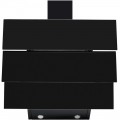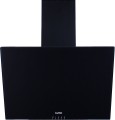Motor power
The power of the hood at maximum speed.
The more powerful the device, the more performant it is, usually. However, there is no rigid dependence here, and hoods of the same power may differ in actual performance. So it is worth evaluating power consumption in terms of power first of all: the lower this indicator, the more economical the device. And when evaluating performance, you need to look not so much at power as at the directly claimed flow of the air (see below).
Flow of air (motor)
The maximum flow of air or motor flow of air indicates the theoretical capability of the device. This parameter of the hood (motor) is measured during idle operation. By connecting the duct and working in the appropriate mode of extraction, the flow of air will be lower. However, high-performance motors will also give a high flow of air in extraction mode.
Max. noise level
The level of noise produced by the hood in the loudest mode of operation. Usually (but not necessarily) it is the maximum power mode. It affects the comfort during operation of the device, so
quiet hoods will be more preferable, but also more expensive.
The decibels in which the noise level is measured are non-linear units, so it is easiest to use comparison tables to estimate a specific value. Here is the simplest table for the values relevant in this case:
— 35 dB. The volume of a conversation in an undertone (but not a whisper). The lowest maximum noise value in modern hoods. Devices with such characteristics are almost guaranteed not to cause inconvenience: such noise is often blocked by other sounds, for example, the background noise of the street in an open window.
— 40 dB. The volume of a normal conversation. The maximum noise level allowed in a residential area during the day. If the hood is bought for home use, and it is supposed to be turned on often and for a long time, the noise level in the selected device shouldn't exceed this indicator.
— 50 dB. Conversation volume at medium tones.
— 60 dB. Raised conversation.
— 70 dB. Sound background on a busy street, in a crowd of people talking loudly, the sound of a vacuum cleaner motor at a distance of 2 – 3 m.
— 75 dB. Scream or loud laughter at a distance of about a metre.
— 78 – 79 dB. Loud mechanical alarm clock, motorcycle o
...r truck engine. The highest level in modern consumer-grade hoods.
Note that the actual comfort of using the device depends not only on the volume but also on the timbre (tonality) of the noise: for example, a low, even rumble is generally perceived easier than high frequencies with clanging notes. If the hood installation is unsuccessful, the actual noise level may be higher than stated in the specifications. For example, additional noise can be caused by the hum of air in the ducts or rattling from the contact of the vibrating body with the wall. However, when choosing, it is worth focusing on the noise level claimed in the specifications.Grease filter
The type of grease filter normally used in the hood. Usually, it has the appearance of a fine mesh that traps drops of fat and kitchen fumes. The grease filter can be like this:
— Metal. In this case, different materials can be used; most often, the word "metal" means a filter made of a relatively inexpensive alloy, and aluminium and stainless steel are usually listed separately (see below for more details). Common features of metal mesh are strength, durability and reusability: it is enough to wash and dry a dirty filter, after which it is ready for use again.
— Aluminium.
Filters made of aluminium alloys are considered to be very durable, because this material is highly resistant to corrosion. However, such filters are noticeably more expensive than ordinary metal ones (see above).
—
Stainless steel. Mesh made of this material has all the advantages of the metal filters described above; they are very reliable and durable, but at the same time not cheap. As a result, the use of stainless steel is typical mainly for premium hoods.
— Acrylic. A polymeric material similar to plastic. The main and the only advantage of acrylic filters is their low cost. At the same time, their service life is much shorter than that of metal ones. And some of these filters are generally disposable and cannot be cleaned after clogging. As a result, such filters are used mainly in low
...-cost models of hoods, and even then quite rarely.Controls
The control method provided in the hood.
—
Push-buttons. The most popular control method in modern hoods can be provided in devices of any functionality and price category — from low-cost models, where buttons directly control the motor, to high-end solutions with advanced electronic circuits.
—
Rotary knobs. Control with rotary knobs, sometimes supplemented by buttons or touch sensors. A rather specific option found mainly in high-end hoods, where rotary knobs are part of the design.
—
Slider. Control using the lever moved on the special panel. Usually, only power is regulated in this way: the farther the slider is from the neutral position, the more air the hood draws. A fairly universal control method, found in hoods of all price categories.
—
Touch controls. Control using touch panels is considered a sign of expensive high-end hoods. It is because it makes sense to use such panels mainly with advanced control electronics and they are poorly suited for low-cost devices. From a practical point of view, the touch controls are remarkable for their ease of use and ease of cleaning: a light touch is enough to give a command, and the panel itself has no slots or protrusions, making it easy to clean dirt.
Remote control
A remote control allows you to control the functions of the hood from a distance. Such a remote control will be especially convenient for those who, due to low height or health problems, find it difficult to reach for the hood itself every time. At the same time, this function affects the cost of the device, and the need for it arises relatively rarely. Therefore, the presence of a
remote control is typical mainly for rather expensive models.
Sleep timer
A timer that automatically turns off the hood after a predetermined time. With such a system, you do not need to wait until the completion of ventilation and turn off the device manually — just set the timer, and you can safely leave the kitchen on your own business; the hood will turn itself off at the right time.
Duct diameter
The duct diameter characterizes the size of the hood outlet to which the ducts are connected. The standard is either
120 mm or
150 mm. In many cases, an adapter from one diameter to another can additionally be included with the device. However, when replacing the hood with a new one, it is still better to operate with the existing pipe diameter and not use adapters.
Height (min)
The minimum height of the entire hood structure is from the lower edge to the upper part of the body (the point of connection of the external air duct). This parameter is indicated only for hoods with an adjustable design that allows you to change the height. Pay special attention to the minimum height if the device is planned to be installed in a kitchen with a low ceiling. In this case, it should be assumed that the optimal height of the air intake above the hob is 60-80 cm, and between the hood body and the ceiling, a headroom is required for the air duct. With a low ceiling, a hood that is too large may simply not fit into your kitchen.

